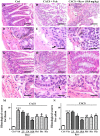trans-Resveratrol Ameliorates Stress-Induced Irritable Bowel Syndrome-Like Behaviors by Regulation of Brain-Gut Axis
- PMID: 29962949
- PMCID: PMC6013570
- DOI: 10.3389/fphar.2018.00631
trans-Resveratrol Ameliorates Stress-Induced Irritable Bowel Syndrome-Like Behaviors by Regulation of Brain-Gut Axis
Abstract
Background: Irritable bowel syndrome (IBS) is a functional disorder characterized by abdominal pain and abnormalities in defecation associated with psychiatric disorders such as depression and anxiety due to the dysfunction of brain-gut axis. This study aims to determine whether trans-Resveratrol affects chronic-acute combined stress (CACS)-induced IBS-like symptoms including depression, anxiety and intestinal dysfunction. Methods: ICR male mice were exposed to the CACS for 3 weeks. trans-Resveratrol were administrated daily (2.5, 5, and 10 mg/kg, i.g.) 30 min before CACS. Behavioral tests were performed to evaluate the treatment effects of trans-Resveratrol on IBS. Hippocampus tissues were collected and processed Golgi staining and immuno-blot analysis. Ileum and colon tissues were collected and processed Hematoxylin and Eosin staining and immuno-blot analysis. Results: Administration with trans-Resveratrol before CACS for 3 weeks significantly reversed CACS-induced depression- and anxiety-like behaviors and intestinal dysfunction in mice, which implied a crucial role of trans-Resveratrol in treatment of IBS-like disorder. Furthermore, trans-Resveratrol improved hippocampal neuronal remodeling, protected ileal and colonic epithelial barrier structure against CACS insults. The further study suggested that trans-Resveratrol normalized phosphodiesterases 4A (PDE4A) expression and CREB-BDNF signaling that were disturbed by CACS. The increased pCREB and BDNF expression in the hippocampus were found, while decreased pCREB and BDNF levels were observed after treatment with trans-Resveratrol. Conclusions: The dual effects of trans-Resveratrol on stress-induced psychiatric and intestinal dysfunction may be related to normalization of PDE4A expression and subsequent pCREB-BDNF signaling in the hippocampus, ileum and colon.
Keywords: anxiety; depression; irritable bowel syndrome; phosphodiesterases 4A; trans-Resveratrol.
Figures






References
-
- Barnette M. S., Manning C. D., Price W. J., Barone F. C. (1993). Initial biochemical and functional characterization of cyclic nucleotide phosphodiesterase isozymes in canine colonic smooth muscle. J. Pharmacol. Exp. Ther. 264, 801–812. - PubMed
LinkOut - more resources
Full Text Sources
Other Literature Sources

